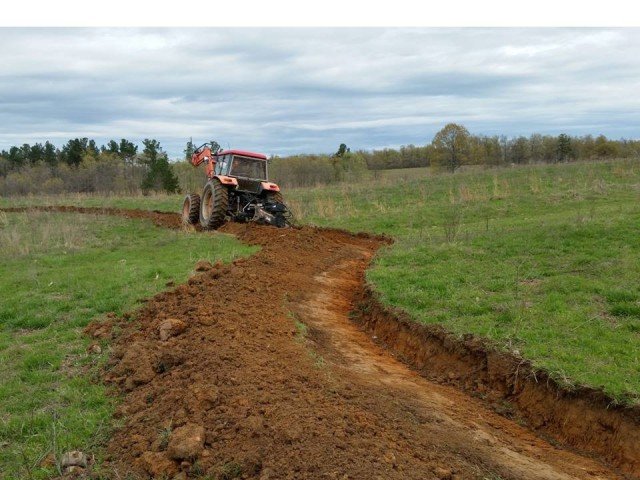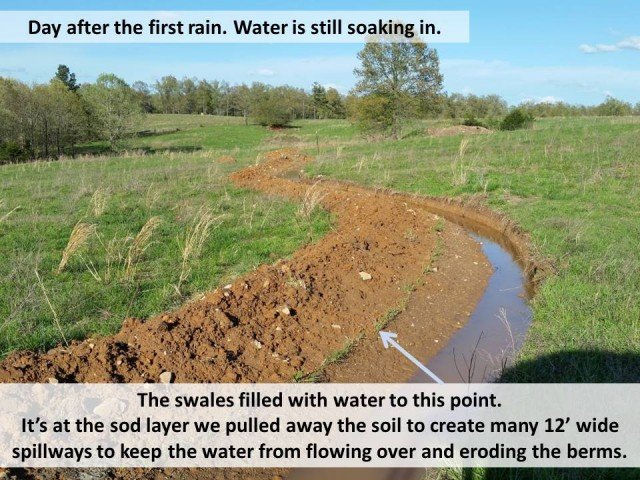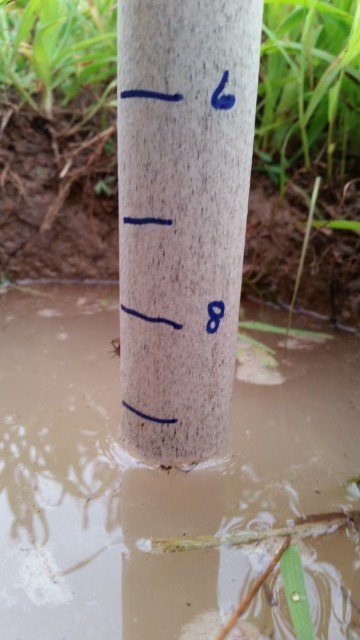Discover the Wild Leek (Ramps)
Learn how the influence of ramps has built relationships within
Learn how the influence of ramps has built relationships within
What is a composting toilet? A composting toilet is a
Here is the latest presentation and virtual tour of how
Spring is here at Midwest Permaculture. It’s time for the
3 Miles of Swales Cut in 5-Hours
We are making early progress on our 320-acre Missouri permaculture-farm project (Jordan Rubin’s Heal the Planet Farm). Last fall, a local dozer operator was brought in to dig the first swales. It was a small dozer but it did a respectable job and did the work in a relatively short period of time compared to an excavator. See the blog post with video here.
Before we brought the dozer back in this spring, Kevin, a long-time farmer in the area who is also Jordan’s lead farmer on this project, suggested that we simply try the 135hp farm tractor with it’s 9-foot tilting scraper blade (it’s just over 6′ wide when fully angled at 45 degrees) to see what kind of swales it would cut. It certainly seemed worth trying though I’d never seen it done before.
Adam and I headed out early one morning with the laser level and marked off about a mile of swales with white-wire flags. When Kevin arrived later in the morning with the tractor all he had to do was adjust the angle of the blade, drop it down, and start running. He ran three passes on every swale we had marked and did it all in about 60 minutes!
We repeated this process over the next two days and in the end Kevin had cut about 3 miles of swales in about 5 hours including the time it took to put in the spillways.
This is huge… for with just a basic farm tractor and a simple blade the farm is now capable to holding an additional 100,000 gallons of water every time there is a good rain and the swales fill. And with all of the rain they have had this spring it probably comes to 1/2 million gallons of water that has now soaked into the landscape rather than running off into the ravines and creeks.
Is this really helpful? Because of the poor quality of the farm’s soils (low organic matter, compaction, clay) it’s ability to absorb water is very limited. The recent soil percolation tests we did showed that the soil can only absorb 1/3 – 1/2 inch of rainfall per hour. When 2 inches of rain pours down within a one-hour period (not uncommon here) that means that most of it runs off the property adding to flooding conditions down stream and leaving plants thirsty just a few days later. What if the farm had absorb all 2 inches! No flooding downstream. More water for plants. Better plant growth. Greater yields. It’s all very simple math really.

I

I

I

I

I

I

I

I


|
|
|
I know this is not a common way to cut swales and the water sits towards the back of the cut instead of soaking into the berm, but for the amount of time it takes to put them in and for the amount of water the swales hold, it certainly seems like it might be a perfect option for many other permaculture design projects. It’s perfect for us because the swales also create the contour template from which our keyline plowing plan will work from. More on that later.
Give us a shout if you have questions.
If you have already experimented with a tractor blade or you end up trying what we’ve done, please share with us what sort of results you get. The more we learn from each other…the better.
Toward a greener world… Bill
P.S. Cody asked a great question in the comments below about mowing. If one does not have livestock to keep the vegetation down, and this is important to do, here is a sketch of how to approach maintenance. Remember, the scraper blade that cut the swales is 9′ wide but when angled as fully as possible (45 degrees) it cuts a swath just over 6′ wide, perfect for a 6′ wide brushmower.
